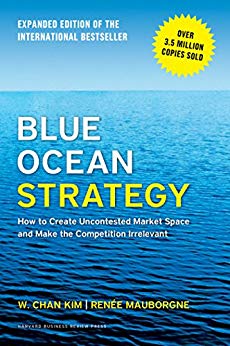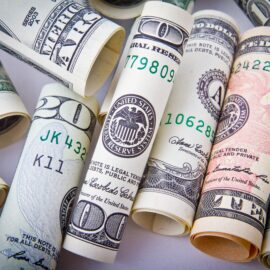

This article is an excerpt from the Shortform summary of "Blue Ocean Strategy" by W. Chan Kim and Renee Mauborgne. Shortform has the world's best summaries of books you should be reading.
Like this article? Sign up for a free trial here .
How is pricing determined in the blue ocean strategy? What are the benefits of low-cost pricing?
Blue Ocean Strategy authors W. Chan Kim and Renée Mauborgne advise setting your price to maximize the number of buyers in your market. In other words, you want to select a price that will make your product attractive to as many potential customers as possible.
Keep reading to learn about the blue ocean strategy pricing approach.
Pricing to Maximize the Number of Customers
The authors say that appealing to as many buyers as possible up front has several advantages over the common practice of starting with a premium price to attract early adopters and then gradually lowering prices to attract mainstream customers:
1. Often, appealing to the maximum number of buyers maximizes profits, because in many industries, fixed costs (one-time expenses associated with launching your product) are high and marginal costs (ongoing expenses associated with delivering each unit that you sell) are low, so attracting more buyers will subsidize your fixed costs while not costing you much more per customer. This is particularly true in software and R&D-heavy industries.
2. Many products benefit from network effects, where the value of the service scales with the number of users.
(Shortform note: Reid Hoffman and Chris Yeh devote most of their book Blitzscaling to these two points. They explain how the internet has driven marginal costs to near zero in many cases, and discuss the “first-scaler advantage” created by network effects. They point out that by growing quickly from the outset, you can reduce the risk of a competitor gaining this advantage before you do. This reinforces Kim and Mauborgne’s blue ocean strategy of pricing for the masses up front.)
3. Strategic prices help earn a reputation for your brand immediately, making it harder for others to copy your strategy and turn your blue ocean into a red one.
(Shortform note: According to Ries and Trout, market leadership is self-perpetuating in this way. They assert that it is almost impossible to displace a market leader, once people view them as such, because brand loyalty drives greater demand and their reputation makes it easier for them to raise capital for expansion and attract the best talent to their workforce.)
How do you actually set your price? According to Kim and Mauborgne, the blue ocean strategy pricing approach is a two-step procedure: First, you establish a price range by researching pricing for major alternatives. Then you select a price within that range based on how difficult it is for others to imitate your offering. Let’s consider each of these steps in more detail:
Determine the Right Price Range
Kim and Mauborgne advise that you start by cataloging the alternatives to your product so you can establish the range of prices that customers might expect to pay for a product like yours. They note that some alternatives may look different but serve the same function— for example, cooking your own food can serve the same function as eating at a restaurant. They also note that some alternatives may serve completely different functions but still achieve the same objective—for example, rock-climbing gear and video games serve very different functions, but they can fulfill the same objective of connecting with friends in a thrilling environment.)
(Shortform note: When considering pricing, it may be worth considering product alternatives as well, because your customers may consider them. Moore defines product alternatives as products with different purposes that are based on the same technology. For example, an electric egg beater and an electric drill are used for completely different things, but they are made up of essentially the same components: an electric motor, a power supply, a gearbox, a coupling mechanism to hold the drill bits or beaters, and so forth. Consequently, it makes sense that they should cost about the same.)
The authors advise that higher prices may increase the amount of profit per customer, but not necessarily enough to increase overall profit, if you make fewer sales. To help you zero in on the range of prices that will give you the highest total revenue, Kim and Mauborgne present a graphic tool they call the “price corridor map.” It’s a graph with price on the vertical axis and a measure of how similar or different the product is to yours on the horizontal axis. The more different a company is from yours, the further to the right it should lie on the horizontal axis.
Plot each alternative as a circle on the graph. Different alternatives will likely have different numbers of customers, so draw larger circles to represent alternatives with more customers and smaller circles for products with fewer customers.
According to Kim and Mauborgne, you can then use the distribution of circles on the graph to identify a horizontal band representing the range of prices which you would expect to earn the most total revenue.
Here’s an example:
Shortform Commentary: Another Way of Visualizing Your Optimal Price Range
Kim and Mauborgne’s graph shows expected revenue only indirectly: The size of the circles correlates to the number of buyers, while the position of each circle shows the price, so to get the total revenue of any alternative, you would multiply the price by the number of customers.
To identify the range of prices that maximize revenue, a different kind of graph might be more suitable. Specifically, for each alternative, you could first multiply the price by the number of customers who buy that particular alternative to calculate the total revenue. Then, you could plot the revenue on the y-axis against price on the x-axis, and fit a bell curve or polynomial approximation to the data. The curve shows you the relationship between revenue and price, which is what you need to know to select the price range that will yield the most revenue.
For example, suppose you have the following list of alternative products:
| Offering | Unit Price | User Base | Revenue |
| Alternative A | $10.00 | 1000000 | $10000000 |
| Alternative B | $20.00 | 200000 | $4000000 |
| Alternative C | $25.00 | 1000000 | $25000000 |
| Alternative D | $25.00 | 25000 | $625000 |
| Alternative E | $30.00 | 100000 | $3000000 |
| Alternative F | $35.00 | 500000 | $17500000 |
| Alternative G | $40.00 | 400000 | $16000000 |
| Alternative H | $45.00 | 14000 | $630000 |
| Alternative I | $55.00 | 5000 | $275000 |
| Alternative J | $65.00 | 5000 | $325000 |
| Alternative K | $75.00 | 10000 | $750000 |
Your graph would look like this:
This graph allows you to see the expected revenue at a given price point directly. However, the one thing it doesn’t show you that Kim and Mauborgne’s original graph does is how similar each alternative is to your product. Admittedly, buyers are more likely to compare your product with alternatives that are more similar to it. But product similarity is sometimes difficult to quantify. Thus, Kim and Mauborgne’s “price corridor map” may offer advantages for intuitive assessment of your ideal price range, while this graph facilitates a numerical assessment of what price range will generate the most revenue.
Specify a Price Level Within Your Price Range
Now that you have a price range, Kim and Mauborgne advise setting your price based on two factors:
- The defensibility of your product
- The relative benefits of scale
According to Kim and Mauborgne, the defensibility of your offering depends on:
- Legal protection through patents, copyrights, or other intellectual property
- Exclusive assets or capabilities that make your offering difficult to imitate
(Shortform note: Author Thomas L. Friedman argues that patents have become less relevant today, because many new inventions become obsolete faster than you can get a patent on them. It typically takes four to five years for the patent office to process and grant a patent. This shifts the emphasis of defensibility more toward capabilities that are difficult to replicate.)
According to Kim and Mauborgne, the benefits of scale depend on:
- The significance of network effects (how much your offering becomes more attractive as your user base grows)
- The ratio of fixed costs to marginal costs
(Shortform note: As Hoffman and Yeh explain, there can also be corresponding costs that limit your scale. First there is the human limitation: Maybe your product becomes more beneficial as more people adopt it, but if it also requires more personnel to support it as the user base grows, this benefit comes at a cost. Hoffman and Yeh point out that the complexity of managing a team grows exponentially with the size of the team, so the fewer employees it takes to support a given number of customers, the lower the costs of scaling up. Second, are the limitations of your infrastructure. This influences your ratio of fixed to marginal costs, because the more you spend on production infrastructure up front, the more you can drive down the marginal cost of production, but at the outset you have a finite budget for infrastructure.)
Kim and Mauborgne argue that the more defensible your product is, the higher you can set your price, but the greater the benefits of scale, the lower you’ll want to set the price, to accelerate mass adoption.
(Shortform note: Arguably, scale is part of defensibility, because of the first-scaler advantage. If your product has significant network effects, then having a large user base increases its value relative to alternatives with fewer users, making it harder for them to compete with you. Even without network effects, the larger your operation, the more expensive it is to replicate.)
Account for Costs
Once you have your strategic price, Kim and Mauborgne advise you to calculate your target cost by deciding what profit margin you want and applying it to your chosen price. They argue that you must not let costs dictate prices, nor should you lower your product’s benefits to match its costs. Doing either will jeopardize mass adoption. Instead, they advise that you aggressively manage your costs to meet your target price. In doing so, you’ll create a product that is more profitable and more difficult to imitate. If you cannot meet your strategic price and maintain an adequate profit margin, they say your idea won’t work and you need to go back to the drawing board.
(Shortform note: Kim and Mauborgne’s directive to figure out your target price first and then manage your costs to achieve it could be considered a business application of Stephen Covey’s directive to begin with your goal in mind. Beginning with a clear understanding of the desired end-state (or in this case the retail price) allows you to chart a course to it and assess its feasibility more definitively.)
As we discussed earlier, blue ocean innovation generally involves reducing or eliminating features that your customers don’t care much about (while adding a unique blend of features that they value). This culling of features up front helps you keep costs down.
Additionally, the authors recommend three more sub-strategies that will help you maintain a profit margin at your strategic price:
Reduce operational costs. There may be new manufacturing processes or materials that offer a cost advantage over traditional ones. Similarly, there may be more cost effective ways of providing services.
- (Shortform note: Some companies are turning to artificial intelligence (AI) to streamline their business operations and thus save costs. AI can perform many payroll and invoicing functions, as well as helping to manage customer relations, and can cut down the need to employ costly workers to do somewhat routine jobs.)
Offload production and distribution activities to capable partners. Kim and Mauborgne say this effectively lowers fixed costs and increases marginal costs. They also point out that it spurs competition among companies trying to win your contract, which drives down prices.
- (Shortform note: Moore also advises partnering with companies who can take on some of your operations, but he cautions against partnering with multiple companies that would be in direct competition with each other, arguing that they’ll be more willing to work with you if you work with them exclusively. In other words, once you select a partner, trying to cut costs further by then partnering with one of their rivals on a different task can backfire.)
Change your pricing structure, such as going from paid to freemium, or from whole-purchase to partial shares or subscriptions. If a customer only buys a portion of the product up front, instead of the whole thing, you can distribute the cost of the product across multiple sales. This allows you to meet your strategic price for each sale, even when you couldn’t sell your product, as a complete unit, for that price and still make a profit.
- (Shortform note: Obviously, even if you defer or distribute your costs over multiple sales, you still need to make a profit in the end. However, the lifetime revenue per customer may be less obvious with these pricing models than with a one-time sale of a complete product up front. Patrick Campbell cautions that many software-as-a-service companies fail because their lifetime revenue per customer is too low in relation to the cost of acquiring each customer, and advises that your revenue per customer needs to be at least three times the cost of acquiring each customer for a subscription service to be viable.)
———End of Preview———

Like what you just read? Read the rest of the world's best summary of "Blue Ocean Strategy" at Shortform . Learn the book's critical concepts in 20 minutes or less .
Here's what you'll find in our full Blue Ocean Strategy summary :
- What blue oceans are, and how you create one for your business
- Why some businesses succeed in creating blue oceans, and why others fail
- The red ocean traps you have to avoid if you want business growth






